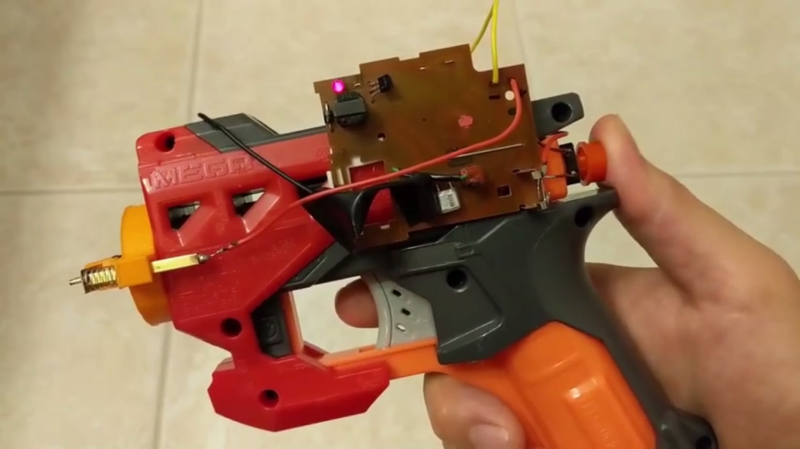For most of us, a good part of our childhood involved running around someone’s backyard (or inside the house) trying to score hits with a toy NERF gun. The fun level was high and the risk of personal injury was low. Now that we’re all mostly adults, it’s probably time to take our NERF game to the next level with some risk of serious personal harm.
In an effort to help his brother get back at him for being somewhat of a bully in their youth, [Allen Pan] gifted him with an upgraded NERF gun. Specifically, one with darts that pack a punch. Each of the “Elite” darts was equipped with a 300 V capacitor packed into the interior of the dart. New tips were 3D printed with special metal tips that allow the capacitor to discharge upon impact.
Besides the danger, there’s a good bit of science involved. Parts were scavenged from a new (and surprisingly expensive) disposable camera, and a customized circuit was constructed around the barrel of the dart gun that allows the darts to charge up when they’re loaded. It’s an impressive build that would be relatively simple to reconstruct for yourself, but it’s probably not the worst thing we’ve seen done with high voltage and a few small capacitors.
Thanks to [Itay] for the tip!















Did this without the fancy stuff half a century ago. Charged a 0.1 microfarad oil cap to 600 and tossed it to a friend. “Here, catch!” No real damage, of course, but [Frank] never trusted me again for anything. Rightly so, I suppose.
What if you packed small capacitors into Nerf darts with prongs, and the gun was able to charge them before being fired? When the dart hits a conductive target, the capacitor discharges the little current it has, the target remains relatively safe, and the next round loads to be charged.
Depending on whether you want a taser-like (disabling) effect, plain capacitors are not the way to go: DC needs a lot of current to incapacitate you, burns will be serious. You’d need to pack some electronics that deliver high voltage high frequency shocks – and for those to take effect, you need time, which means barbed hooks… And then you just recreated the Taser-Shotgun-shell
I suspect he’s using the capacitor and circuit from a one time camera, so the spark is high current, so across a few mm of skin, it should be able to give you a burn.
You suspect? So you didn’t even bother watching the video? Or reading past the second paragraph of the post? Good job.
I watched this video a week ago… Tosser!
And still just suspect?
WTF, is this not suddently 4CHAN? He shows the gun, shoots some foil targets, threatens his room mate and toggles the power switch. At no point in this video is there a closeup of the circuit or the capacitor in the dart. Also he doesn’t narrate anything. Apparently some have seen a different video.
I think you watched a different video, bud.
Somewhere there is a video where somebody catches a charged capacitor and trows it right trough the (closed) window because of the electrical shock. This was an expensive prank…
Cool but maybe next time try the fire bit on a table that is not made of wood?
As far as I see, the dart can be placed in any angle they want to, so… How do they know the capacitor polarity is not inverted? Or they simply put the dart in, and if it doesn’t explode then the polarity was good.
Electronic Goldmine always has bulk disposable camera shells (w flash circuit) on sale
“You’ll shoo^H^H^H^H fry your eye out kid!”
#taser nerf dart = Great video, full of humour. Thanks for totally ignoring the Health & Safety brigade! There was a time when every self respecting kid had a homemade catapult (slingshot) or Bow & Arrows, before progressing onto BB Guns etc. :) Your kid bro is way to kind! If I got the chance to zap my older brother I’d be there in a second lol. I don’t know what the complaints are about on this thread, it’s not exactly difficult to work out what you did, and kudos to you for the solution(s) to the engineering problems that arose. Keep at it dude. Regards Lin. Exeter, Devon. SW UK.
#tasernerfdart Fun Video, thanks !!
We had a lab class in school, the topic was some analog integrator circuits. We got a power supply with symmetric +-12V output, some opamps and bunch of capacitors. +-12V gives 24V and I charged all capacitors, then connected them in series to get something like 240V and managed to make my friend sitting next to me to scream.
I tried making one of these, but it didn’t work. Nobody was shocked.
Wrong!
I’m shocked that it didn’t work!
B^)
word
Make a box with shiny foil wrapping and a ribbon around it. The ribbon hides a gap in the foil. The two halves of the foil are connected to a capacitor.
the real fun is charging up a decent capacitor and tossing it into the urinal your buddy is using.
Who says ITT Tech didn’t teach anything useful lol
This is awesome! We were looking for mod-nerf guns and we came across your video. Thank you